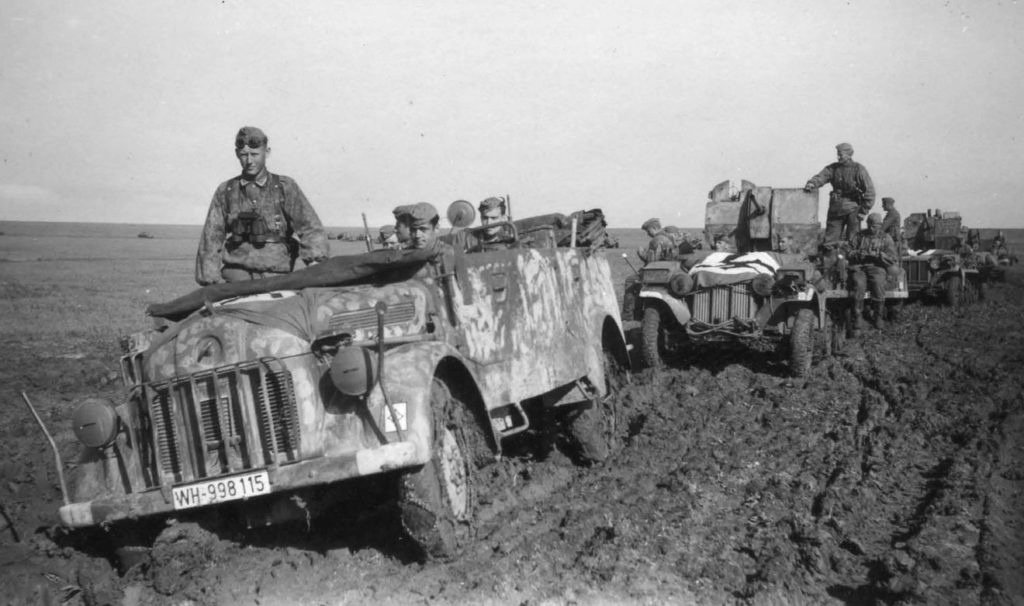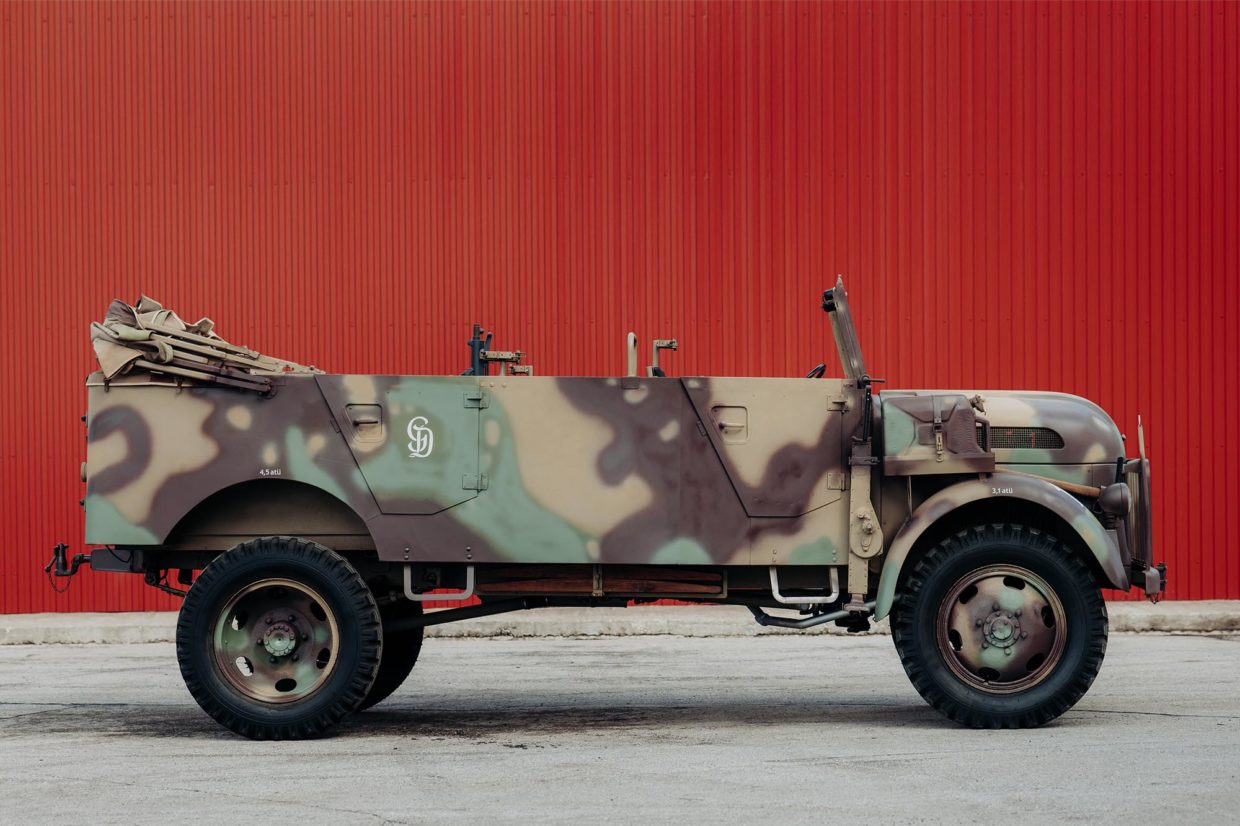This entry is also available in: Russian Chinese (Traditional)
Despite the common stereotype that the Wehrmacht’s technical equipment at the beginning of the war was at a very high level, in reality the German army was in dire need of modern vehicles, especially trucks. For this reason, the choice fell on the company, located in just annexed Austria – “Steyr-Daimler-Puch AG”. By the fall of 1938 a range of special vehicles for delivery to military units on the territory of Germany had already been identified. At the same time there was a request for a half-ton off-road truck.
Only after the involvement in 1940, the design office of Ferdinand Porsche in a short time the model Porsche Typ.147 was realized, which later was named Steyr 1500A. There was an early model 1500A/01, which was produced exclusively in Austria, a year later there was an updated model 1500A/02, which was produced at two other companies in Germany: Wanderer, which was part of the Auto Union in Sigmar and Audi in Zwickau. A characteristic feature of the updated model was a spare tire between the side doors.

The model was produced in three basic versions: a light truck, infantry transporter, and luxury vehicle for officers of high rank.
In our museum the Steyr 1500A/02 model of 1942 is represented in a modification Kzf 12 – the medium cross-country vehicle with a turret of a light anti-tank or field artillery gun. The body type was a Kübelwagen.
Most US, French, and Soviet production vehicles were equipped with four or six-cylinder engines, but Porsche Typ.147 had a V-shaped air-cooled gasoline V8 engine, which was indexed Steyr-V8-365l. The engine had a capacity of 3,517 cm3 and a maximum power of 86 horsepower. This allowed acceleration of the car on paved roads up to 90 km/h and to overcome difficult terrain at a speed of 40 km/h. The average consumption of Steyr 1500A was about 23 liters per 100 kilometers. A full tank of 100 liters was gone in about 400 kilometers.
Transmission has a number of design features: it is based on a 4-speed manual gearbox with a dry single-plate clutch, the scheme of the all-wheel-drive – 2-speed transfer gearbox with a clutch disconnecting the front axle. The use of a reduction range of transfer gears was intended to compensate for the use of single wheels on the rear axle.
Dimensions of the truck were very impressive, given the two-axle configuration:
- Length 5088 mm
- Width of 2030 mm
- Height: 2320 mm.
- The weight varied from 16,885 to 21,860 lbs.
Karosserie, Wagonbau (Austria) and Lohnen made body extensions. Thus, in addition to the basic versions, there were versions for more specialized tasks: all-metal vans for radio stations, fire trucks, trucks to transport wounded soldiers, open-top basic staff cars with short side doors, an awning with add-on windows and a searchlight, designed to carry 10 people.

From September 1941 to March 1944, 12,450 vehicles had been produced in Austria and an additional 5,600 came from factories in Germany. The last 100 cars were produced in May 1944. An interesting fact is that the Steyr 1500A remained in production even after the other major automobile factories working for Nazi Germany have switched to the production of engines for various equipment – mainly aircraft and tanks.
From the unambiguous advantages of this model can be allocated versatility of its application due to competent modular design, high recoil, which allowed to load the vehicle up to 1500 kilograms while maintaining the two-axle configuration. This was made possible largely due to the unusual solution of using a V8 engine under the hood. The SUV had excellent handling and an outstanding top speed of 90 km/h.
However, the decision to use single tires on the rear axle was a drawback. Despite the fact that the transmission used a 2-speed timing box, the lack of a second pair of tires had a negative impact on the off-road performance of the vehicle. The successor of the hero of our article – Steyr 2000A – had a solution to this problem, which was produced in both single and double tires on the rear axle.
The history of this off-road vehicle, which participated in countless battles during the Second World War, is closely associated with car companies, which in one form or another exist today. They would later give us great civilian cars and achieve great success in automotive sports in peace, post-war times.
“Steyr-Daimler-Puch AG gave the world an off-road legend, the Mercedes Benz G-Classe, which to this day is still produced by hand at the Magna-Steyr plant in Graz, Austria, by the slipway method. The Wanderer plant would later become part of Auto Union, which would later evolve into Audi AG, the world’s first brand to implement all-wheel drive in a passenger car. Ferdinand Porsche and his teams of engineers would never again design military vehicles and would switch to the civilian sector and the construction of sports cars, which would quickly acquire the status of legends and conquer the podiums of most automotive competitions.
Technical Specifications
| Manufacturer | Steyr-Daimler-Puch, Austria / Wanderer, Germany / Horch, Germany | .
| Years of manufacture | 1941 – 1944 | .
| Number, pcs | 12,450 – Austria, 5,600 – Germany | .
| Cost | .. |
| Cost in current prices | .. |
| MOTOR AND TRANSMISSION | .|
| Type | 8-cylinder, V-shaped | .
| Engine displacement, cm3 | 3,517 | .
| Piston diameter and stroke, mm | 78 x 92 |
| Power output | 85 hp | ignition | electric starter | electric starter. |
| Carburetor | . |
| Cooling | air | .Grip | air clutch | .
| Gearbox | 4-speed |
| Wheelbase and wheelbase | .|
| Frame type | .. |
| Front suspension | independent |
| Rear suspension | spring suspension |
| Brakes | drums on all wheels |
| Wheel dimensions | |
| DIMENSIONS | .|
| Length, mm |
5 230
|
| Width, mm |
2 035
|
| Height, mm |
2 460
|
| Wheelbase, mm |
3 250
|
| Ground clearance, mm |
245
|
| Mass, kg |
2 500
|
| Petrol tank capacity, l |
100
|
| Maximum speed, km/h |
90
|
| Range, km | |
*- Data based on the results of the measurement on the “Motorworld by V.Sheyanov” exhibit.




























































